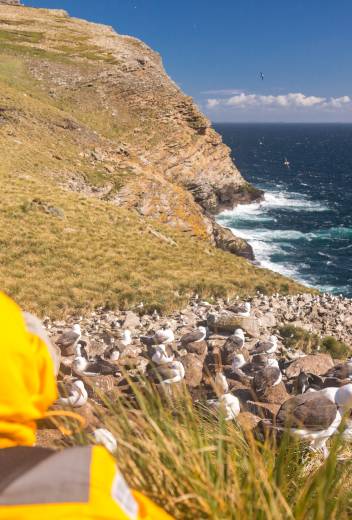
Polar travelers love seeing penguins on their Antarctic expeditions, and Quark is delighted to support an initiative to ensure we can continue to meet and interact with penguins for generations to come.
Penguin Lifelines is an initiative led by one of our penguinologists, Dr. Tom Hart. It examines the reasons for the decline of penguins in the world and takes steps to try to reverse the trend.
(Right) Dr. Tom Hart installing cameras in the field. Photo credit: Penguin Lifelines facebook page
What Issues Face Penguins Today?
Dr. Hart says climate change has been happening at a rate that is too fast for some penguins to adapt.
“The truth is the future looks pretty bad,” he says. “They are likely to decline more, particularly unless we can address climate change and fisheries.”

Photo credit: Penguin Lifelines facebook page
“It’s important not to talk about extinction, because in some areas penguins are doing fine, but in the peninsular region (of Antarctica), where the effects of climate change are worse, they’re doing pretty badly.”
Fisheries, disease and pollution are some of the other problems contributing to penguin population decline. Penguin Lifelines has a goal of using its research to educate the public and inform policy on what can be done to prevent further decline.
How Does Penguin Lifelines Work?
Penguin Lifelines is run through Oxford University and the Zoological Society of London. Dr. Hart also makes frequent trips to Antarctica for his research, which includes camera trapping, population genetics and photos taken by volunteers.

Photo credit: Penguin Lifelines facebook page
Now, penguin lovers need not wait until their Antarctic trip to view penguin habitats. They can view penguins in their natural habitat and help support Penguin Lifelines from home, through the Penguin Watch website. The site enables people to monitor penguins in some of the most remote regions on Earth by annotating penguin sightings. Currently, over 8,000 volunteers are helping by annotating images of penguins and other wildlife in Antarctica and the Southern Ocean.

Viewing and annotating these images helps Penguin Lifelines count and track penguin populations, and is instrumental in programing software to recognize penguins in these wildlife areas. In future, monitoring and analyzing penguin populations will require far less time and legwork.
Participating is as simple as visiting Penguin Watch and getting started.
Through Penguin Lifelines, people can also “adopt a colony” by donating funds to place a web camera in Antarctica. This monitoring process is minimally disruptive and enables researchers to monitor penguin populations in their natural environments, year-round.
Supporting a Sustainable Future for Antarctica
Travelling to Antarctica with Quark Expeditions is a tremendous opportunity to engage with people passionate about penguins on your Antarctic vacation, and become more aware of the challenges our polar ambassadors face.
“A lot of people are surprised to hear that penguins are declining and Antarctica is changing,” Dr. Hart says. “There’s a lot of concern and support, once they learn what’s happening in the region, and can see it with their own eyes.”
Penguin Lifelines is one of the many sustainability initiatives supported by Quark. We support these and other causes with the help of our guests. Onboard auctions have raised an average of $150,000 each season, all of which is directed to charities with a mandate of sustainability and conservation.
We are active members of the International Association of Antarctica Tour Operators (IAATO) and of the Association of Arctic Expedition Cruise Operators (AECO) and, as such, are deeply committed to environmentally responsible tourism. Join us in our conservation efforts as we support Penguin Lifelines!









